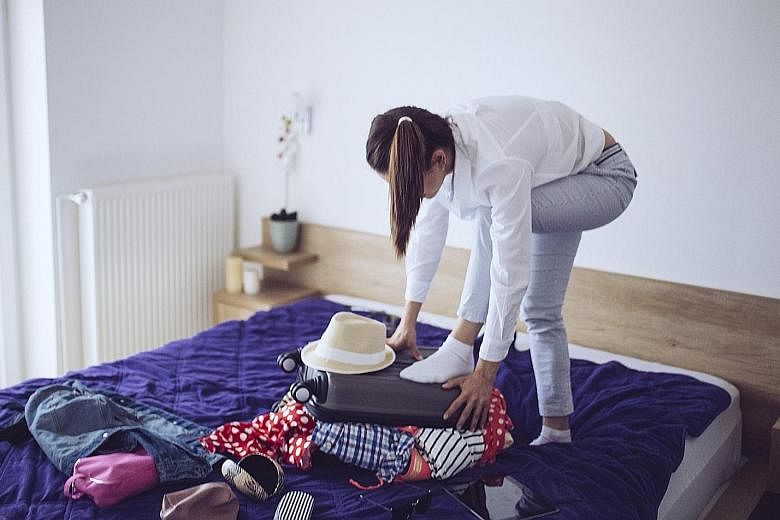When my partner and I got married in December 2014, one of my biggest wedding challenges was not the floral arrangements or choosing the dinner menu, but deciding what to pack.
We had planned a winter wedding in Prague, envisioning a sky lit by fireworks, rooftops dusted with snow, our guests enjoying mulled wine and dancing off the cold - but a frosty honeymoon afterwards? Not so much.
Instead we went south, opting to spend our first weeks as a married couple along the balmy coasts of Cape Town and in the deserts of Namibia which, in early January, were at the height of a Southern Hemisphere summer.
Cue packing nightmare. How does one prepare for an antipodal holiday and its contrary climes? Within the constraints of an airline baggage allowance, no less?
It's also a problem when travelling to temperate regions in the shoulder seasons, months like May or September, when the tourists have thinned but the changing weather is unpredictable.
I recently returned from a 10-day road trip up the Croatian coast, and when I started in early September, I was wearing shorts and T-shirts. The sun was high and the weather warm. But by the time I was in the north, summer had quickly turned to a cold and rainy autumn and I was snug in a sweater, my head wrapped in a scarf. When temperatures can fluctuate from sub-10 to 30 deg C in a matter of days, you don't want to be unprepared.
So what can a traveller do? Here then are some tips for packing for all weathers.
KNOW YOUR LIMITS
Consider the key restraints: weight and space. There are only so many bags and kilos that airline passengers can take on board. Dear chronic over-packers (such as myself), come to terms with the fact that you are travelling. You will not have access to your full wardrobe, and that's okay.
KNOW YOUR DESTINATION
Where are you going and what will you be doing there? Will most days be spent by the beach? Will there be skiing? Are there plans for a fancy dinner? Lay out all the appropriate clothing for your itinerary.
CULL
Think of all the times you have returned from a trip with clothes which have gone unworn. In reality, you need far less than you think you will. Be practical and realistic and cut your piles by half or more if you tend to overpack. Take only what is truly necessary.
Remember to keep summer clothing to a minimum, knowing that thicker winter clothes will take up most of the suitcase. I try to separate my suitcase, reserving two-thirds of it for winter clothes and one-third for summer, placing toiletries, shoes and accessories in the suitcase lid compartment, or flat on top of the clothes.
DOUBLE DOWN
Prioritise clothes that can do double duty, such as tank tops, cotton shirts and blouses for summer that can be layered under sweaters in winter. Pack flats or loafers in neutral shades and materials which can be used in any season. For nice dinners, pack a dress that can be worn with sandals as well as stockings and flats, or a dress shirt that works just as well with shorts as under a jacket or sweater.
BIGGER ISN'T ALWAYS BETTER
Winter wear requires layers, but they don't have to take up too much space. High-tech, insulating thermal wear can be quite thin, and a 100 per cent wool sweater or high-quality fleece can be a centimetre thick at most and still keep the wearer warmer than a chunky, loose knit jumper.
Add a few pairs of wool socks (I wear a pair of cotton socks underneath the thicker wool socks on particularly cold days), a scarf, a hat and a pair of gloves, and you're set. The better quality the fabric, the fewer layers you will need to stay comfortable.
DON'T FORGET YOUR CARRY-ON
Utilise carry-on space. Excluding shoes and toiletries, a week's worth of summer clothing should be able to fit into a carry-on suitcase. Then dedicate the check-in baggage to bulkier winter wear.
If you can't bear to leave that favourite chunky knit sweater behind, carry it on board. The same goes for a winter jacket which can add 2kg to 3kg to check-in luggage. Stuff it in the overhead compartment instead.
Likewise, it's best to wear the heaviest and bulkiest shoes on to the plane. This will help save on suitcase space. While they may not be the most comfortable shoes, most people will take their shoes off once they're on board anyway.
FILL THE SUITCASE CORNERS
Stuff any shoes still in the suitcase with rolled up socks, leggings and underwear. Don't waste this valuable space. I also find that rolled clothes fill awkward spaces and troughs in suitcases much better than their folded counterparts. Rolling clothes also helps keep them tightly packed together, so more items can fit in the suitcase.
TRAVEL-SIZE TOILETRIES
Once the clothes have been sorted, it's time to do the same with toiletries, which can add a surprising amount of weight to luggage.
Again, take only what you need. Squeeze a favourite shampoo or conditioner that you can't do without into reusable travel-size bottles, which can be bought cheaply from stores like Muji or Daiso. A 100ml of each doesn't sound like much, but it should be more than enough to last for two weeks.
These stores also sell little plastic pots which are ideal for face creams and serums, so the full jar can be left behind. I also try to take travel-size perfume and make-up options, which can be bought at Duty Free or Sephora stores.
Packing make-up and toiletries in travel-size packaging has an added benefit. If upon check-in, your suitcase is overweight, placing toiletries in a carry-on bag is one of the easiest ways to remove extra kilos. And using smaller packaging means you can do this without busting airline limits for carry-on liquids.
TAKE ADVANTAGE OF TRANSITS
If using the same airport as a transit point between destinations, consider leaving a suitcase with the airport's luggage storage service.
Major airports such as London's Heathrow and Munich Airport provide secure rooms where passengers can store luggage for a few hours up to months at a time for less than $15 a day.
So if it is possible to pack by destination, travellers can avoid carrying unnecessary clothes by checking a winter suitcase at the airport, then exchanging it for the summer suitcase when transiting to their next destination.
This is especially convenient when your itinerary includes flying regional airlines, which often have lower luggage weight limits than international flights.
Those travelling to Europe using Munich as a hub between Arctic Norway and southern Spain can store their Spanish suitcase at the airport while they head north, then exchange it when travelling back through Munich, for example.
IT'S NOT THE END OF THE WORLD
Ultimately, when packing for two seasons, trim clothes, accessories and toiletries down to the bare necessities, and remember that if you have run out of something, department stores or laundry facilities are rarely very far away.


